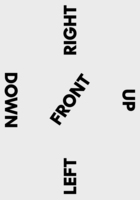This Side Up
Alexandra Bachzetsis & Julia Born-
-

- Julia Born for the Architectural Association, 2007 — Side 1
-
As an extension to the work Secret Instructions, which explored the language of stage directions, this inquiry focuses on the spatial dimension of movement instruction. The mapping of movement is just as elusive as the recording of thought. A countless number of forms have been established that have attempted to solve the problem of recording, preserving and transferring movement into a readable form. Some of the early graphic recordings of dance movements were formed from simple pattern-like floor plans that marked the paths of the performers from a birdseye view. Later these developed into more complex systems that used symbols and letter codes, or borrowed the signs of musical notation. ‘Labanotation’, invented in 1928 by the dance theorist and former architect Rudolf von Laban, became the first notation to be designed from the perspective of the performer, as opposed to that of the audience.
Methods of instructing a body on stage have ranged from total control and precision to open structures. Samuel Beckett was known for his serious concern for structure and meticulous description. Late in his career he became an active participant in the theatrical process, re-editing and sometimes even rewriting his plays in rehearsals, working together with the actors. On the other hand, Merce Cunningham was influenced by Zen and Dadasim and deliberately operated with processes of chance in order to liberate himself from the restrictions of convention. Similarly, Richard Kostelanetz’s book Scenario compiles scripts to be performed that ‘induce travellers to take routes they had not experienced before, perhaps making perceptions they would otherwise have missed’. Some of these scores offer mere ideas or suggestions that are entirely open to interpretation, written by artists who had obviously never studied playwriting.
The challenge of transcribing movement can be seen to lie within the simultaneity of its elements: the movement itself in three dimensions, the concept/idea behind it, alignment in space, and time/duration as the fourth dimension. Purely verbal directions without a physical demonstration of the movement or the use of metaphors are rather imprecise. The need for reference is crucial for spatial orientation as well as for communication in general: the meaning of a basic description like ‘up’ or ‘down’ can alter depending on the standpoint. These blind spots of language create interesting moments of ambiguity that will be explored in collaboration with performer Alexandra Bachzetsis.
-
-

- Julia Born for the Architectural Association, 2007 — Side 2
-
-
-

- Labanotation system
-
-
-

- Spread from Changes: Notes on Choreography by Merce Cunningham, Something Else Press, 1968
-
-
-

- Spread from Samuel Beckett: Dramatic Works (volume unspecified) by Samuel Beckett, Grove/Atlantic, pp. 380–1
-
-
-

- Spread from Scenarios, ed. Richard Kostelanetz Assembling, 1980, pp. 234–5
-
-
-

- Eshkol-Wachmann system, ‘The individual spheres and their relation to the general system’
-
-
-

- ‘Hands Up!’ from Ann Hutchinson Guest, Labanotation: The System of Analyzing and Recording Movement, 1970, reprinted 1989 and 2004
-